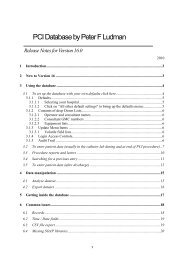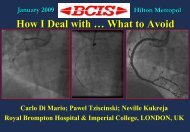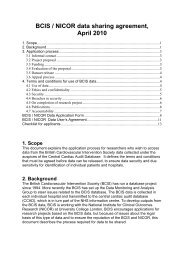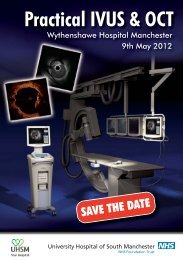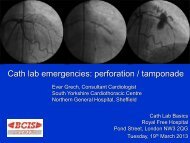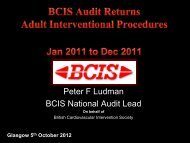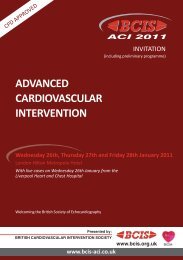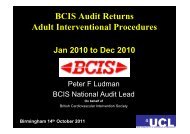Recommendations
ACC/AHA/SCAI PCI Guidelines - British Cardiovascular Intervention ...
ACC/AHA/SCAI PCI Guidelines - British Cardiovascular Intervention ...
- No tags were found...
You also want an ePaper? Increase the reach of your titles
YUMPU automatically turns print PDFs into web optimized ePapers that Google loves.
30<br />
Smith et al. 2005<br />
ACC/AHA/SCAI Practice Guidelines<br />
ACC - www.acc.org<br />
AHA - www.americanheart.org<br />
SCAI - www.scai.org<br />
The Quality-Assessment Process<br />
Quality assessment is a complex process that includes more<br />
than mere tabulation of success and complication rates.<br />
Components of quality in coronary interventional procedures<br />
include appropriateness of case selection, quality of procedure<br />
execution, proper response to intraprocedural problems,<br />
accurate assessment of procedure outcome, and appropriateness<br />
of postprocedure management. It is important to consider<br />
each of these parameters when conducting a qualityassessment<br />
review. A quality program performs appropriately<br />
selected procedures that achieve risk-adjusted outcomes,<br />
in terms of procedure success and complication rates, that are<br />
comparable to national benchmark standards. Patient characteristics<br />
that determine appropriateness are discussed elsewhere<br />
in this document. Multivariate models that predict risk<br />
have been published previously (43,47,305-308).<br />
It is accepted that quality-assurance monitoring is best conducted<br />
through the peer review process despite the political<br />
challenges associated with colleagues evaluating each other.<br />
There has been a considerable controversy surrounding<br />
efforts to define standards, criteria, and methodologies for<br />
conducting quality assessment. There are many challenges to<br />
conducting this process in a fair and valid manner.<br />
The cornerstone of quality-assurance monitoring is the<br />
assessment of procedural outcomes in terms of success and<br />
adverse event rates. Other components of quality-assurance<br />
monitoring include establishment of criteria for assessing<br />
procedure appropriateness and application of proper risk<br />
adjustment to interpret adverse event rates. Because adverse<br />
events should be rare, a valid estimate of a properly riskadjusted<br />
adverse event rate generally requires tabulation of<br />
the results of a large number of procedures. This adds an<br />
additional challenge to the valid assessment of low-volume<br />
operators and institutions. The responsible supervising<br />
authority should monitor the issues outlined in Table 13<br />
(309).<br />
Initial Physician Operator Credentialing Criteria<br />
The institutional credentialing committee should document<br />
that an interventionalist wishing to initiate practice meets the<br />
established training criteria, including those of the ACC Task<br />
Force on Training in Cardiac Catheterization and<br />
Interventional Cardiology (310-312). The ACC Training<br />
Statement (312) for coronary invasive training requires a 3-<br />
year comprehensive cardiac program with 12 months of<br />
training in diagnostic catheterization, during which the<br />
trainee performs 300 diagnostic catheterizations, with at least<br />
200 of those as the primary operator. Interventional training<br />
requires a fourth year of fellowship, during which the trainee<br />
should perform more than 250 but not more than 600 interventional<br />
procedures (312). The physician’s training program<br />
director should certify that the candidate has completed<br />
the program and has achieved the necessary competence<br />
to perform coronary interventional procedures independently.<br />
The certification should also include whether the candidate<br />
has achieved requisite competence in related interven-<br />
tional techniques such as rotational atherectomy, balloon<br />
valvuloplasty, and closure of patent foramen ovale and atrial<br />
septal defect.<br />
It is recommended that an interventional cardiology operator<br />
be certified by the American Board of Internal Medicine<br />
in interventional cardiology. Ideally, board certification in<br />
interventional cardiology should be required for credentialing.<br />
The American Board of Internal Medicine certifying<br />
examination in interventional cardiology has been administered<br />
annually since 1999. As of the 2004 administration, a<br />
total of 4718 individuals have been certified.<br />
Privilege Renewal<br />
Criteria for practitioner privilege renewal should be based on<br />
both activity level and outcomes. The assessment process<br />
should ascertain whether a physician operator’s activity level<br />
is sufficient to maintain competence. In addition, the assessment<br />
process should assess the appropriateness of the operator’s<br />
case selection and compare the operator’s risk-adjusted<br />
outcomes with established national benchmark standards<br />
(310). This is discussed in depth in Section 4.2. Current<br />
benchmark standards for mortality, complication rates, and<br />
risk adjustment will be subject to future revision as procedure<br />
technique is refined and newer data emerge. It is important<br />
that institutions assist with these efforts by participating<br />
in active database efforts to track clinical and procedural<br />
information for individual operators and their institutions.<br />
Outcome Data Tabulation and Reporting<br />
Institutions performing PCI should gather data needed to<br />
monitor their outcomes and should submit their data to a<br />
national registry for benchmarking purposes. Institutions<br />
should conduct meticulous record keeping that details the<br />
cases performed-patient demographics and comorbidities,<br />
Table 13. Key Components of a Quality-Assurance Program<br />
Clinical proficiency<br />
General indications/contraindications<br />
Institutional and individual operator complication rates, mortality<br />
and emergency CABG<br />
Institutional and operator procedure volumes<br />
Training and qualifications of support staff<br />
Equipment maintenance and management<br />
Quality of laboratory facility [See ACC/SCAI Expert Consensus<br />
Document on Catheterization Laboratory Standards (309)]<br />
Quality improvement process<br />
Establishment of an active concurrent database to track clinical and<br />
procedural information and patient outcomes for individual operators<br />
and the institution. The ACC-NCDR ® or other databases are<br />
strongly recommended for this purpose<br />
Radiation safety<br />
Educational program in the diagnostic use of X-ray<br />
Patient and operator exposure<br />
ACC indicates American College of Cardiology; CABG, coronary artery bypass graft surgery;<br />
NCDR ® , National Cardiovascular Data Registry; and SCAI, Society for<br />
Cardiovascular Angiography and Interventions.



